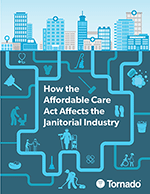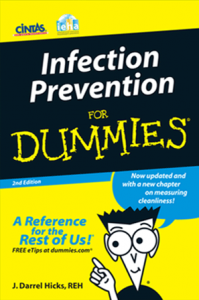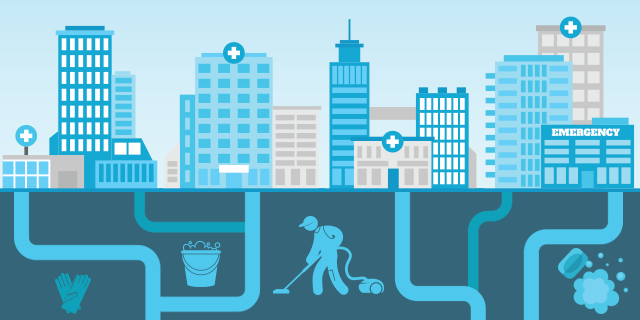Recoup Medicare Reimbursements by Cleaning for Health
Last week, we discussed how the Affordable Care Act (ACA) made sweeping changes to Medicare payments by tying them to outcomes. The new reimbursement policies are comprehensive and touch all aspects of patient care, including housekeeping.
 The Takeaway
The Takeaway
Learn more about the affordable care act
and how it affects the janitorial industry.
DOWNLOAD
Now that you better understand how the ACA affects your hospital’s income, let’s focus on strategies to help your department be a proactive partner in maximizing Medicare payments.
Cleaning for Health
Two critical metrics the government now uses for assessing Medicare reimbursements are rates of healthcare-associated infections and readmissions. To avoid penalties, housekeeping departments must clean for health, not appearance.
The process starts, Hicks says, by developing a comprehensive plan that covers cleaning equipment and tools, procedures and frequencies, and janitor training.
“If you don’t have a structured program that addresses every area of the hospital, you don’t survive,” he says. “There’s a lot to consider. It’s a complex, daily problem facing housekeeping directors.”
When it comes to best practices for procedures, Hicks says hospitals must do a better job of removing soil from surfaces before using disinfectant. This can be accomplished with vacuuming or microfiber mops and rags.
“Those soils harbors a lot of bad bacteria that needs to be removed in order for it to be a healthy room,” Hicks says. “Physically removing soil first to create a pre-cleaned surface makes whatever disinfectant you use much more effective.”
Other processes to consider, he says, are using color-coded tools to prevent cross-contamination, adding hand sanitizer dispensers to encourage hand hygiene, and providing hospital staff with disinfectant wipes so they can help keep surfaces clean.
“Clean hands and clean surfaces save lives,” Hicks says.
Finally, thorough and ongoing training of housekeeping staff is a must.
“If you educate the staff on the reasons for cleaning this way, they’ll more easily connect the how with the why.”
 Want to know more?
Want to know more?
Read the Centers for Disease Control’s complete guidelines for environmental infection control in healthcare facilities.
CDC GUIDELINES
Patient Satisfaction
While delivering best-in-class cleaning is vital for reducing HAIs and lowering readmission rates, it’s not always enough to hit 100% reimbursement rates. That’s because customer-satisfaction scores are being given greater weight in determining how much money a hospital will receive from the federal government.
Most patients aren’t experts in disinfection or cross-contamination, which means survey responses are based on perceptions of cleanliness, not measurable metrics.
“They patient may perceive that you didn’t mop the floor if they don’t see a string mop,” Hicks says. “That’s why communication is so important.”
Housekeeping crews should be encouraged (or required) to interact with patients when cleaning their rooms, Hicks says. Go over this process during training, he says, and consider writing a script for new and shy staff.
First, janitors should introduce themselves to the patient and any family in the room. Next, they need to explain that they are cleaning and disinfecting to prevent the spread of germs. Finally, before leaving ask if the patient feels the room is clean.
“If you do that, then patient satisfaction scores will go up,” Hicks says. “We are beyond being timid about it. You have to hire people who are outgoing and can converse with people. You can teach someone to properly clean and disinfect, but not everyone has people skills.”
If the patient and family aren’t in the room during cleaning, the housekeeper should leave a note with her name, what she did, and whom the patient should contact if they feel more cleaning is required. Hicks suggests getting pre-printed cards made to speed up this process.
“It communicates to them that although they didn’t see you clean the room, you were there,” Hicks says. “If they don’t see you, their perception is you didn’t clean.”
Similarly, patients may also have outdated notions about a room only being clean if it smells a certain way. Hicks says it may be worthwhile to choose cleaning products that have a clean, fresh scent to address this perception.
By investing in cleaning for health and patient satisfaction, the housekeeping department can shine as an MVP by helping the hospital recoup major dollars in Medicare reimbursements.
Special thanks to Mr. Darrel Hicks for contributions to this article.

J. Darrel Hicks, BA, Master REH
Darrel is the owner/principal of Darrel Hicks, LLC., specializing in B2B consulting, webinar presentations, and facility consulting services related to cleaning and disinfection. He is nationally recognized as an expert in cleaning related infection prevention and control, and has written and published numerous articles as part of his commitment to providing a cleaner, safer and healthier indoor environment.
In 2010, Hicks authored “Infection Prevention for Dummies”, a 43-page, pocket-size book with topics such as: Use cleaning techniques to keep infection at bay; Match the disinfectant to the situation; Understand disinfectant label claims; and Keep your environment healthy.
Was this article helpful?
Sign up for Tornado’s newsletter for more info like this.
Watch your email and follow our blog posts for more info on topics impacting businesses and for ways to grow your business!

